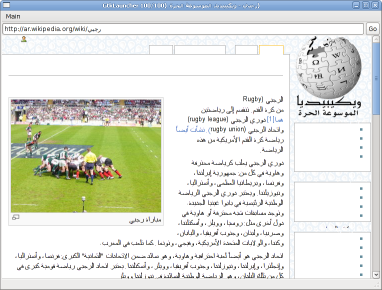A good week for text and graphics
glyph-pixmaps
Carl‘s glyph-pixmaps work has been merged to xserver. This provides a speedup for text rendering by hashing and caching glyph data to avoid constant re-uploads. Eric Anholt breaks it down for us.
Cairo and XShm
Shared memory has had a bad rap when it comes to X11, and it’s been found in the past that it doesn’t provide a significant performance benefit over sockets at the transport level (SMT).
However, when it comes to image data, XShm can provide a “sensible performance optimization” by avoiding gratuitous copies. To take advantage of this, you need to do a little work to ensure that the data can be shared directly with the X server. Chris Wilson has just proposed a patch to support this in Cairo.
WebKit and complex text
I’ve started work on support for complex text in WebKit/Gtk+ using Pango. This includes support for non-Western writing systems.

To continue today’s performance theme, it’s worth noting that WebKit provides two code paths for text rendering:
- Blazing flast: Known as the CG path on OS X, this path caches glyph data and avoids expensive computations wherever possible. In the GTK+ port, this code path requires direct use of the font-system on every supported platform. Luckily, it turns out the WebKit code base already has optimised text implementations for several platforms, which we can just borrow and plug in to our own port.
- Fast: The ATSUI path on OS X, this path is capable of complex text rendering, while still providing opportunities for caching layout information from previous text runs. Here, we use Pango, along with a few clever tricks.
A heuristic is applied to detect which code path can be used. Since the capabilities of Pango are slightly different to ATSUI, this may yet need some tweaking to avoid more fallbacks then are necessary.

Does this mean the font selection problems are over ?
I hope you know what you do with the heuristic – modern fonts use opentype tricks even in latin/greek/cyrillic unicode blocks, so bypassing pango may not work so well for any script.
glandium: The Imendio guys have a patch for font selection. It’s independent of my changes here, though the two features will fit together nicely. See http://bugs.webkit.org/show_bug.cgi?id=15229 (Bug 15229: [gtk] abstract font management by using pango).
Nicolas: You are right, it is tricky. We will learn what the right balance is as we get more users, and when we do formal benchmarking.
[…] #15610: International/complex text rendering support using Pango. The Imendio guys are working to complete and integrate my initial work on this feature. […]